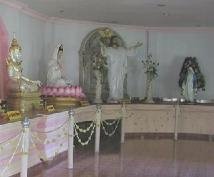An iceberg in Ilulissat
Photo courtesy Uta Wollf on Wikimedia
In
By Colin Woodard
Ilulissat,
Surrounded by icebergs, Sunni, Shiite, Buddhist, Hindu, Jewish, Christian, and Shinto leaders committed themselves last Friday to leave the planet "in all its wisdom and beauty to the generations to come." They included the Grand Rabbi of Paris, René-Samuel Sirat, Bishop Sofie Petersen of
They are in
Patriarch Bartholomew, who is based in
Now he is taking on climate change, traveling down the
"Preservation of the environment, promotion of sustainable development, and particular attention to climate change are matters of grave concern for the entire human family," said Bartholomew at the conference's opening.
Mending schisms
Carl Pope, executive director of the Sierra Club, says the event was indicative of the progress that was being made bridging the divide between environmentalism and faith. "Environmentalism is really the intersection of science and ethical principles," he says. "I was part of the generation that made the choice – the horrendous strategic blunder – of situating ourselves outside the institutions of faith. Now we have a chance to repent for and reform from that error."
Religious leaders also signaled the need to work together.
"It is very, very key for as many voices from as many fields as possible to come together to present a common effort," Cardinal McCarrick, Pope Benedict XVI's official representative, told the Monitor. Failure to address climate change, he said, "will mean the terrible suffering of millions of people."
Mr. Ball, an influential Baptist minister, said the event had considerable symbolic importance. "The image of all the religious leaders on the boat with the Ecumenical Patriarch says that we recognize this and that it's time for us to get busy, and for all hands to get on deck," he said.
Bartholomew, the head of the ancient "mother church" in
He has declared the destruction of nature a sin, and built relationships with other religious and political leaders engaged in environmental causes. In 2002, he signed a joint declaration on the environment with the late Pope John Paul II, helping ease centuries of tension between the Catholic and
Glacial melting triple that of '02
The Ilulissat glacier in west-central
"The amount of ice that comes into the ocean in a day could provide the water supply for any of the largest cities in the world for an entire year," says Robert Corell, director of the global change program at the H. John Heinz III Center for Science, Economics, and the Environment in Washington who has studied Greenland's glaciers for decades.
Some scientists argue that increased snowfall over parts of
Global sea-level rise estimates in the latest report of the International Panel on Climate Change were based on data from 2005 and predicted a rise of eight to 24 inches over the century, says Corell. But more recent data has made it clear that Greenland's massive ice cap is collapsing much faster, and that sea levels will rise roughly three feet as a result. "The rate of melting is just phenomenal," he says.
(c) Copyright 2007. The Christian Science Monitor




No comments:
Post a Comment